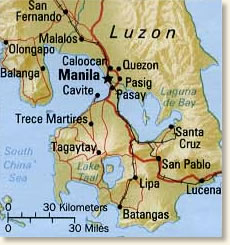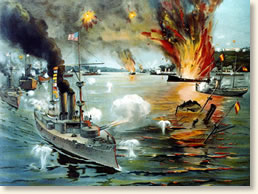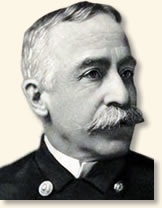|
The Battle of Manila Bay, 1898
America's war with Spain lasted only 3 months and cost the U.S. an estimated 400 killed or wounded. The conflictís historical importance lies in the fact that, with its victory, America took its first step in its journey to becoming a world power. As part of the spoils of war, the United States acquired the Philippines, Puerto Rico and Guam, while Cuba gained its independence from Spain. For Spain it was a humiliating defeat. Both her Atlantic and Pacific fleets were sent to the bottom of the sea - with them went Spain's prestige as a world power.
 |
| The Battle of Manila Bay |
The roots of the conflict lay in America's revulsion at the ruthless Spanish reaction to the Cuban insurrection that began in 1895. The "Yellow" journalism of the Hearst and Pulitzer newspapers fed the American public's war-fever with sensationalist stories about Spanish atrocities. Emotions reached flash point with the sinking of the Battleship Maine in Havana harbor on February 15, 1898.
Congress declared war on April 25. Spain sued for peace on August 12. The conflict formally ended with the Treaty of Paris concluded on December 10 and ratified by Congress on February 6, 1899. Major engagements in the war included the Battles of Santiago Bay and San Juan Hill in Cuba and the Battle of Manila Bay in the Philippines
The conflict in the Pacific was one-sided. At the declaration of war, Commodore Dewey, commander of America's Asiatic Squadron based in Hong Kong was ordered to race his six ships to the Philippines. He arrived at Manila Bay on May 1 and found the obsolete Spanish fleet anchored in the bay. It was a one-sided battle. The Americans were out-numbered but the Spanish were out-gunned and underprepared. At the battle's end the entire Spanish fleet lay at the bottom of the harbor. Dewey lost eight wounded and one dead (due to heat stroke). The victory cleared the way for the capture of Manila on August 13.
Commodore Dewey sent the following description of the battle to his superior shortly after its conclusion:
"U. S. NAVAL FORCE ON ASIATIC STATION, Flagship Olympia, Cavite, Philippine Islands, May 4, 1898.
SIR: I have the honor to submit the following report of the operations of the squadron under my command:
The squadron left Mirs Bay on April 27, immediately on the arrival of Mr. O. F. Williams, United States consul at Manila, who brought important information and who accompanies the squadron.
Arrived off Bolinao on the morning of April 30 and, finding no vessels there, proceeded down the coast and arrived off the entrance to Manila Bay on the same afternoon. . .
The Boston and Concord were sent to reconnoiter Port Subic, I having been informed that the enemy intended to take position there. A thorough search of the port was made by the Boston and Concord, but the Spanish fleet was not found, although, from a letter afterwards found in the arsenal it appears that it had been their intention to go there.
Entered the Boca Grande, or south channel, at 11:30 p.m., steaming in column at distance at 8 knots. After half the squadron had passed, a battery on the south side of the channel opened fire, none of the shots taking effect. The Boston and McCulloch returned the fire.
 |
| A Contemporary Rendition of the Battle |
The squadron proceeded across the bay at slow speed, and arrived off Manila at daybreak, and was fired upon at 5:15 a.m. by three batteries at Manila and two at Cavite and by the Spanish fleet anchored in an approximately east and west line across the mouth of Bakor Bay, with their left in shoal water in Canacao Bay
The squadron then proceeded to the attack, the flagship Olympia, under my personal direction, leading, followed at distance by the Baltimore, Raleigh, Petrel, Concord, and Boston, in the order named, which formation was maintained throughout the action: The squadron opened fire at 5:41 a.m. While advancing to the attack, two mines were exploded ahead of the flagship, too far to be effective.
The squadron maintained a continuous and precise fire at ranges varying from 5,000 to 2,000 yards, countermarching in a line approximately parallel to that of the Spanish fleet. The enemy's fire was vigorous, but generally ineffective.
Early in the engagement two launches put out toward the Olympia with the apparent intention of using torpedoes. One was sunk and the other disabled by our fire and beached before an opportunity occurred to fire torpedoes. At 7 a.m. the Spanish flagship Reina Chnstina made a desperate attempt to leave the line and come out to engage at short range, but was received with such galling fire, the entire battery of the Olympia being concentrated upon her, that she was barely able to return to the shelter of the point. The fires started in her by our shell at this time were not extinguished until she sank.
At 7:35 a.m., it having been erroneously reported to me that only 15 rounds per gun remained for the 5-inch rapid-fire battery, I ceased firing and withdrew the squadron for consultation and a redistribution of ammunition, if necessary.
The three batteries at Manila had kept up a continuous fire from the beginning of the engagement, which fire was not returned by this squadron. The first of these batteries was situated on the south mole head at the entrance to the Pasig River, the second on the south bastion of the walled city of Manila, and the third at Malate, about one-half mile farther south. At this point I sent a message to the Governor-General to the effect that if the batteries did not cease firing the city would be shelled. This had the effect of silencing them.
At 11:16 a.m., finding that the report of scarcity of ammunition was incorrect, I returned with the squadron to the attack. By this time the flagship and almost the entire Spanish fleet were in flames, and at 12:30 p.m. the squadron ceased firing, the batteries being silenced and the ships sunk, burnt, and deserted.
 |
| Commodore Dewey |
At 12:40 p.m. the squadron returned and anchored off Manila, the Petrel being left behind to complete the destruction of the smaller gun-boats, which were behind the point of Cavite. This duty was performed by Commander E. P. Wood in the most expeditious and complete manner possible.
The Spanish lost the following vessels:
Sunk - Reina Christina, Castilla, Don Antonio de Ulloa. Burnt-DonJuan de Austn'a, Isla de Luzon, Isla de Cuba, General Lezo, Marques del Duero, El Correo, Velasco, and Isla de Mindanao (transport).
Captured - Rapido and Hercules (tugs) and several small launches
I am unable to obtain complete accounts of the enemy's killed and wounded, but believe their loss to be very heavy. The Reina Chnstina alone had 150 killed, including the captain, and 90 wounded.
I am happy to report that the damage done to the squadron under my command was inconsiderable. There were none killed and only 7 men in the squadron very slightly wounded. As will be seen by the reports of the commanding officers which are herewith inclosed, several of the vessels were struck and even penetrated, but the damage was of the slightest, and the squadron is in as good condition now as before the battle. . . .
References:
This eyewitness account appears in: Hart, Albert Bushnell (ed.) American History told by Contemporaries vol. 4 (1928); Freidel, Frank, The Splended Little War (1958); O'Toole, G.J.A., The Spanish War: An American Epic (1986).
How To Cite This Article:
"The Battle of Manila Bay, 1898" EyeWitness to History, www.eyewitnesstohistory.com (2011).
| 





